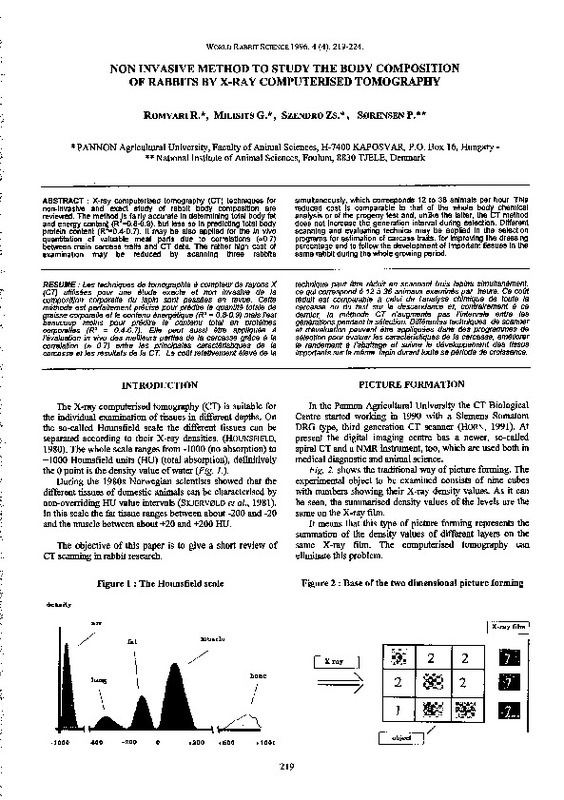JavaScript is disabled for your browser. Some features of this site may not work without it.
Buscar en RiuNet
Listar
Mi cuenta
Estadísticas
Ayuda RiuNet
Admin. UPV
NON INVASIVE METHOD TO STUDY THE BODY COMPOSITION OF RABBITS BY X-RAY COMPUTERISED TOMOGRAPHY
Mostrar el registro sencillo del ítem
Ficheros en el ítem
| dc.contributor.author | ROMVARl, R.
|
|
| dc.contributor.author | MlLISITS, G.
|
|
| dc.contributor.author | SZENDRO, Zs.
|
|
| dc.contributor.author | SORENSEN, P.
|
|
| dc.date.accessioned | 2011-03-21T10:26:16Z | |
| dc.date.available | 2011-03-21T10:26:16Z | |
| dc.date.issued | 1996 | |
| dc.identifier.issn | 1257-5011 | |
| dc.identifier.uri | http://hdl.handle.net/10251/10453 | |
| dc.description.abstract | [EN] X-ray computerised tomography (CT) techniques for non-invasive and exact study of rabbit body composition are reviewed. The method is fairly accurate in determining total body fat and energy contet1! (R2=0.8-0.9), but less so in predicting total body protein content (R =0.4-0.7). lt may be also applied for the in vivo quantitation of valuable meat parta due to correlations (,..0,7) between main carcasa traits and CT data. The rather high cost of examination may be reduced by scanning three rabbits simultaneously, which corresponda 12 to 36 animals per hour. This reduced cost is comparable to that of the whole body chemical analysis or of the progeny test and, unlike the latter, the CT method does not increase the generation interval during selection. Different scanning and evaluating technics maY. be applied In the selection programa for estimation of carcasa traits, for improving the dressing percentage and to follow the development of important tissues in the same rabbit during the whole growing period. | es_ES |
| dc.description.abstract | [FR] Les techniques de tomographie a compteur de rayons X (CT) utilisées pour une étude exacte et non invasive de la composition corporel/e du lapin sont passées en revue. Cette méthode est parfaitement précise pour prédire la quantité totale de graisse corporelle et le contenu énergétique (Rª = 0.8-0.9) mais /'est beaucoup moins pour prédire le contenu total en protéines corporel/es (Rª = 0.4-0. 7). Elle peut aussi etre appliquée a l'éva/uation in vivo des meil/eurs parties de la carcasse grace a la corre/ation ("' O. 7) entre les principales caractéristiques de la carcasse et les résultats de la CT. Le coDt relativement é/evé de la technique peut etre réduit en scannant trois lapins simultanément, ce qui corresponda 12 a 36 animaux examinés par heure. Ce coDt réduit est comparable a celui de /'analyse chimique de toute la carcasse ou du test sur la descendance et, contrairement a ce demier, la méthode CT n'augmente pas l'intervale entre les générations pendant la sélection. Différentes techniques de scanner et d'évaluation peuvent l)tre appliquées dans des programmes de sélection pour évaluer les caractéristiques de la carcasse, améliorer le rendement a /'abattage et suivre le développement des tlssus importants sur le meme lapin durant toute sa période de croissance. | |
| dc.language | Inglés | es_ES |
| dc.publisher | World Rabbit Science. ICTA. UPV | es_ES |
| dc.relation.ispartof | World Rabbit Science | |
| dc.rights | Reserva de todos los derechos | es_ES |
| dc.title | NON INVASIVE METHOD TO STUDY THE BODY COMPOSITION OF RABBITS BY X-RAY COMPUTERISED TOMOGRAPHY | es_ES |
| dc.type | Artículo | es_ES |
| dc.date.updated | 2011-03-21T09:59:22Z | |
| dc.identifier.doi | 10.4995/wrs.1996.298 | es_ES |
| dc.rights.accessRights | Abierto | es_ES |
| dc.description.bibliographicCitation | Romvarl, R.; Mllisits, G.; Szendro, Z.; Sorensen, P. (1996). NON INVASIVE METHOD TO STUDY THE BODY COMPOSITION OF RABBITS BY X-RAY COMPUTERISED TOMOGRAPHY. World Rabbit Science. 04(4). https://doi.org/10.4995/wrs.1996.298 | es_ES |
| dc.description.accrualMethod | SWORD | es_ES |
| dc.relation.publisherversion | https://doi.org/10.4995/wrs.1996.298 | es_ES |
| dc.description.volume | 04 | |
| dc.description.issue | 4 | |
| dc.identifier.eissn | 1989-8886 | es_ES |








